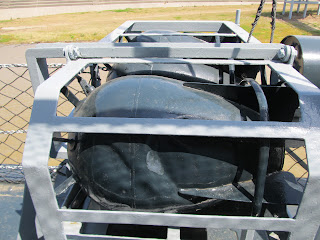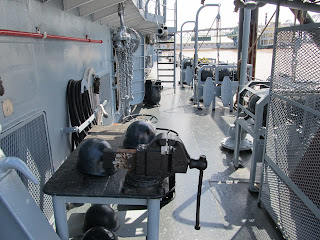The USS Kidd was named after Rear Admiral Isaac Kidd, Sr., killed in action while commanding the defense of Pearl Harbor from His Flagship, the USS Arizona during the Japanese surprise attack on December 7th, 1941. RADM Kidd was posthumously awarded the Medal of Honor for his actions that day. Quoted Directly from the Citation;
"For conspicuous devotion to duty, extraordinary courage, and complete disregard of his own life, during the attack on the Fleet in Pearl Harbor, Territory of Hawaii, by Japanese Forces on December 7, 1941. He immediately went to the bridge and as Commander Battleship Division ONE, courageously discharged his duties as Senior Officer Present Afloat until the USS Arizona, his Flagship, blew up from magazine explosions and a direct bomb hit on the bridge, which resulted in the loss of his life."
The body of Rear Admiral Kidd has never been recovered and he is officially listed as Missing In Action.
Twin .50 caliber AA guns.
Shipboard firefighting equipment.
The Galley, where the meals are prepared.
Those are coal burning stoves.
The Officer's Dining area.
A view of the 5-inch guns at the bow the the ship.
A view toward the stern from the bow.
A torpedo launcher.
Anybody need a shower?
Shells for the 5-inch guns.
More torpedoes
Twin-barreled 40mm Anti-Aircraft gun.
I'd hate to be on the other end of those sights.
Narrow, steep staircases. A tall chubby guy like me would have been in trouble his first few weeks on the Kidd.
Such spacious accommodations for the Officers!
The Crew Quarters, all total there is room for about 1/3 of the Kidd's total enlisted compliment in the birthing area, bunks for around 90 enlisted men. The practice of hot bunking was common, with 2/3 of the crew on duty and the other 1/3 asleep, being rotated on a regular basis. so the bunks were always warm from the crewman sleeping in them.
Enlisted dining area. Note the bunks in the background...
From the bow. More AA and 5-inch guns.
Depth charges for destroying those pesky submarines.
I hope you have enjoyed my adventure aboard the USS Kidd. If you have any questions please feel free to ask. -Mike, still traveling...



















































